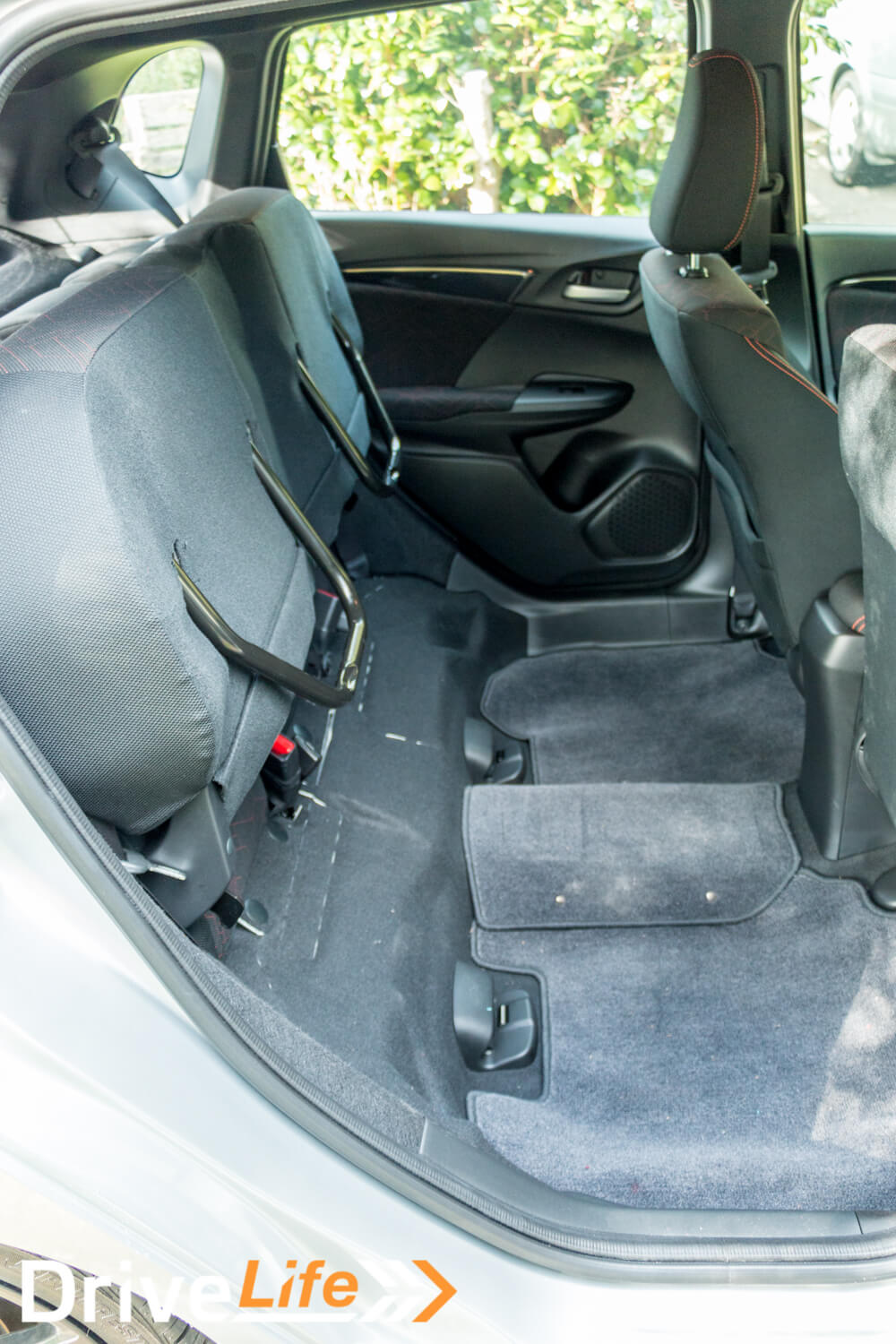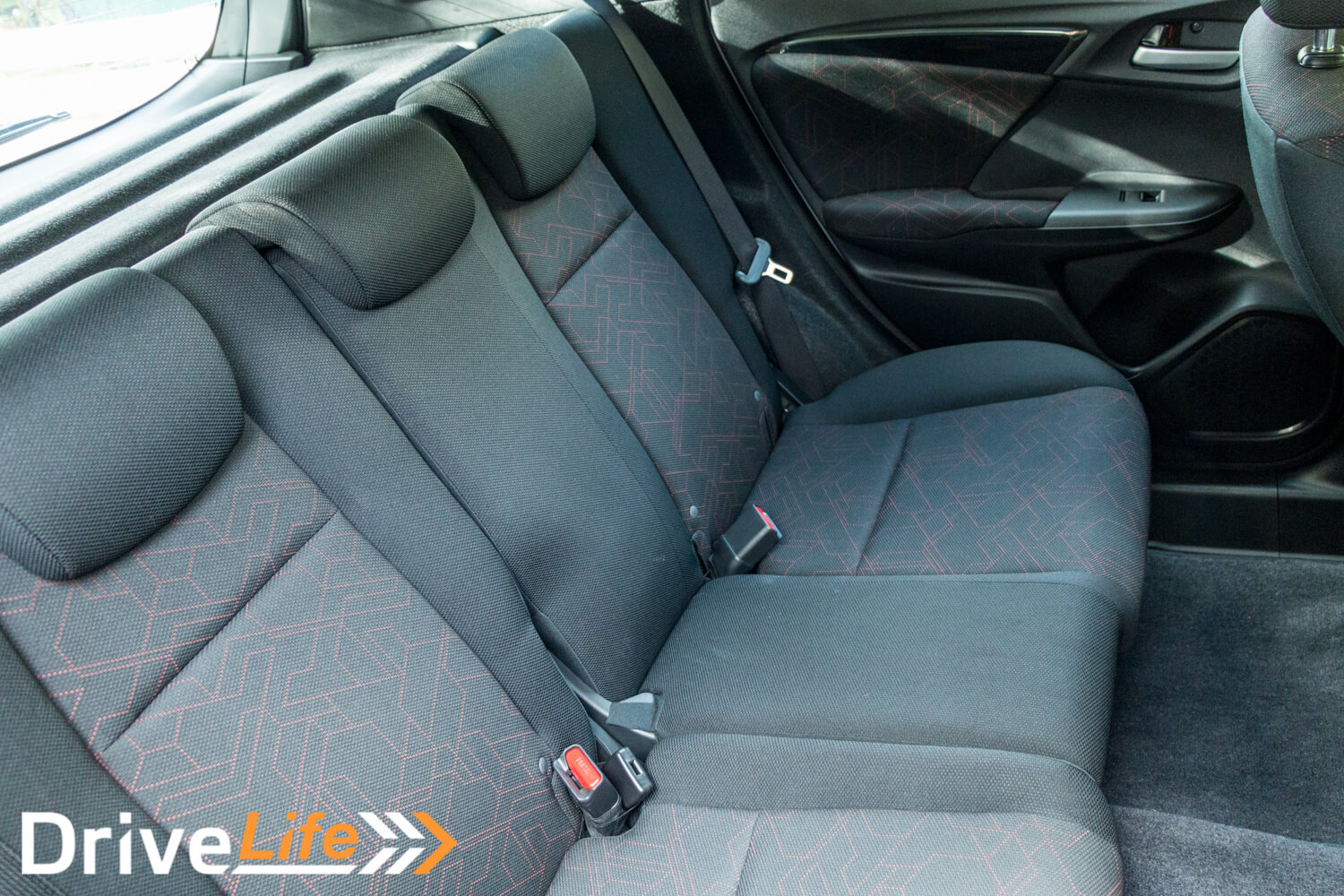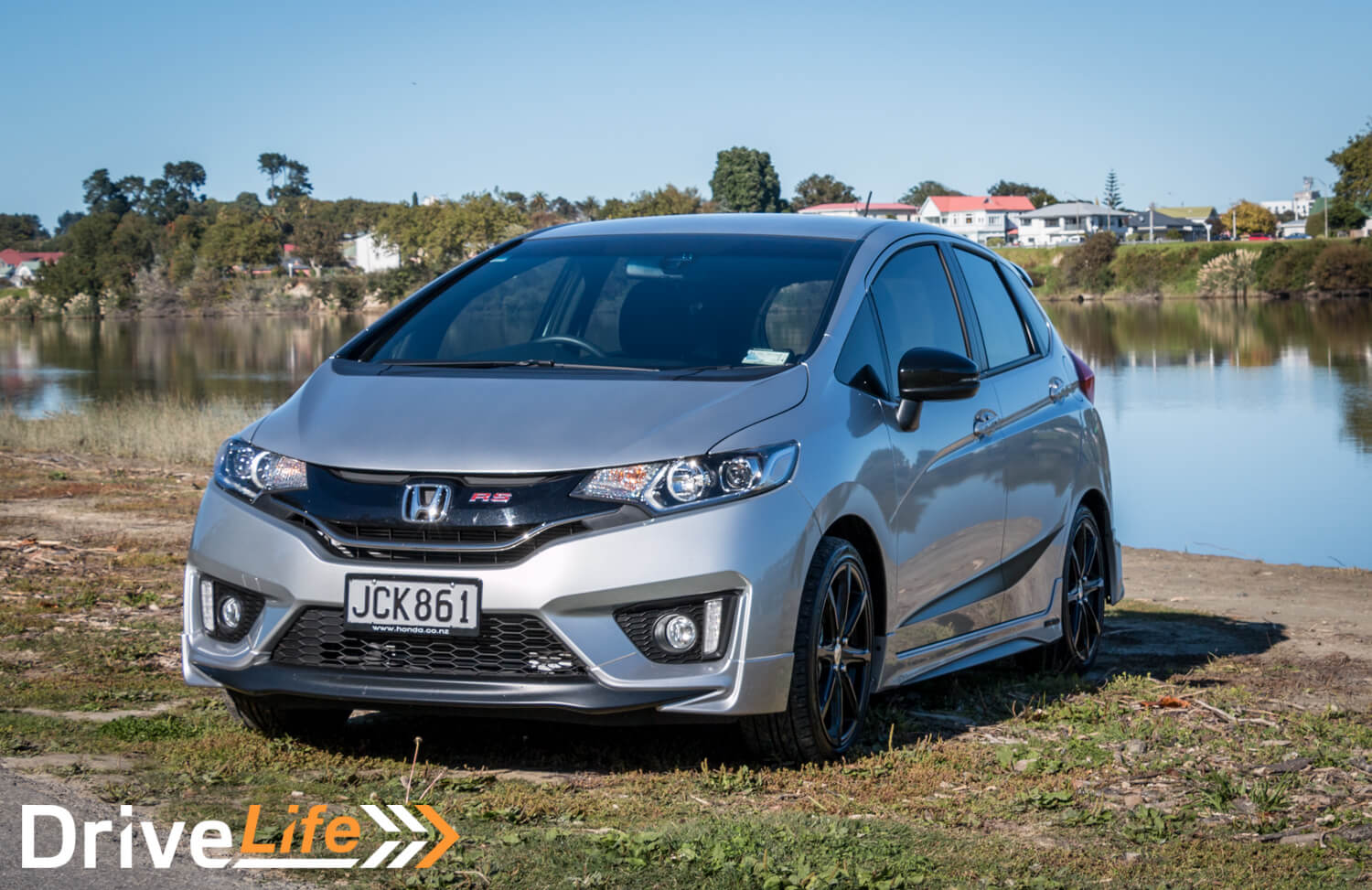You may recall that we tested the third generation Honda Jazz RS a few months ago and Fred was impressed. Honda offered us the top of the range RS Limited model to test and I was excited to see what the higher spec added.
The Jazz is based on the same platform as the Euro Civic, and includes some of the same interior features, including the centrally mounted fuel tank under the front seats which enables a flat floor in the rear and Honda’s clever Magic Seat system (more on that later).
The range consists of the entry-level S, followed by the RS, RS Sport, RS Mugen then the RS Sport Limited, each adding a bit more equipment. There’s a range of ten colours with some nice bold shades, though if you go for the six speed manual version you’re limited to five: black, White, silver, Orange, or a rather lovely metallic blue.
Our test car was Alabaster Silver. I’m not usually a fan of silver but it does look good on the Jazz, especially with the optional black side slashes fitted to our car. These are a $130 addition but they break up the side profile and add something a bit different.
Over the standard RS the Sport Limited adds mostly cosmetic details, the list is: Mugen Sports body Kit (side skirts and front and rear skirts). Black Mugen 17″ Alloys, Mugen Titanium Sports Silencer, Mugen Performance Air Filter, Tinted Windows, Black Painted Wing Mirrors and spoiler. It gives the whole car a more aggressive look, and that exhaust and filter should give some power boost, though Honda don’t quote any different figures. It’s up to you to decide whether these parts are worth a $5k price difference, but it certainly makes it stand out from the standard RS.
The standard RS spec has some impressive features including Hill Start Assist, City Brake Assist, 6 airbags, seatbelt pretensioners, ABS, Electronic Brakeforce Distribution, Emergency Brake Assist, Stability Assist, Traction Control, LED headlights.
First Impressions
At first glance, the dimensions of the Jazz make it look like a small hatchback but take another look and it’s bigger than you expect. It’s just under 4m long and 1.5m tall with a 2.5m wheelbase, which has enabled Honda to make a pretty roomy cabin.
Step into the driver’s seat and it’s a pleasant place to be – and I do mean step – the Jazz seems to be that perfect height for most people where it’s really easy to step in and out of. It’s one of those things that you don’t even realise at first, and the back seats are the same. I suspect this is one of the reasons why I see so many of each generation of Jazz driven by older people.

The dash is a little unusual as the main part of the central dash is one unbroken black plastic surface, incorporating the satnav screen, entertainment system and heating/cooling controls, all touch operated. The only physical buttons on the dash are for the hazard lights, and engine start/stop.
In front of the driver there are three main dials – a big central speedo, with rev counter to the left and a circular information screen to the right. All have blue backgrounds and white text which I think work well.
Visibility is excellent, with that tall windscreen and side windows, along with the flat floor and high roof it makes the interior feel very spacious.
The seats are very good – made of a textured cloth with contrasting stitched highlights. Side bolsters are big enough to hold you in place on corners without being overly sporty, and the back and seat have just the right amount of padding to be comfortable on longer trips.
The leather-clad three spoke steering wheel is nice to hold, and has controls on its face for the stereo and cruise control. It adjusts for height and reach, and the driver’s seat adjusts for height too, so I found it easy to find a comfortable driving position. There’s a foot rest next to the sporty-looking alloy pedals for your left leg.
Entry is keyless with various ways of unlocking the car. You can pull the front door handle, or push the little black button set into the handles (which also locks the car), or there’s a lock/unlock button under the lip of the boot as well. And of course buttons on the remote.
What’s it like to live with?
Get into the car and push the engine start button and the 1.5 litre four cylinder fires up, with a little muted growl from the Mugen exhaust. The satnav, on the other hand, takes a minute or so to boot up. It’s a minor irritation but it does mean that if you want to use the reversing camera you need to wait for it to finish its boot sequence. Like most cars with touch screens there’s a message box to cancel each time you drive the car before the satnav activates. The satnav is great: it shows the current road speed limit in the top right corner, a compass in the top left, lane information pops up when approaching junctions, as does information about upcoming motorway junctions and where they go. Directions are verbose, to the point of being annoying, and I couldn’t find a setting to turn this down, so eventually turned off the voice. Also it refers to freeways, and calls roundabouts circles, which is a bit unusual in New Zealand.
At lower speeds and when maneuvering the car, the steering is very light. A little too light for my liking but it is very accurate and makes the car easy to use. At open road speeds the Motion Adaptive electric steering firms up and gives a more pleasing feel.
I decided to take the Jazz on a road trip to the famous Smash Palace up near Ohakune to get a few parts for my project car. I loaded up the boot with tools and a few empty boxes to pack the spaces and stop things sliding around. I also decided to drop off a set of wheels at a powder coaters in Levin. Time to test the Magic Seats. The rear seats have a clever system where they can completely flat to give a big load area, or upwards to keep the boot enclosed but create a load area inside the cabin. Folding them upwards makes a pretty large storage area, and four 18” wheel boxes fit in there with room to spare. Talking of space, there’s quite a lot in the rear, with plenty of leg room for rear passengers.

An early morning start meant I had the chance to try out the LED headlights, which are excellent. As with most cars with LED dipped beam, the main beams are standard halogens.
I paired my phone to the car via Bluetooth and plugged it into the power socket inside the centre console arm rest. There’s a second power socket at the bottom of the dash as well, and USB, SD card and aux inputs. If you really desperately want a CD/DVD player you can lose the satnav and spec an optional Sony head unit but I don’t know why anyone would. At first I found the sound a bit thin, but after tinkering with the bass a bit and setting the stereo to Rock Mode it sounded much better, with surprisingly good bass.
Like a lot of newer cars, the suspension is pretty firm, but not harsh. It handles bumps and ruts well, and on the open road it feels composed. Performance wise, the Jazz feels a bit sluggish at first, but I soon realised that if you prod the throttle with a bit more enthusiasm it finds some more of its 97kW and nips off the line with more enthusiasm. At the top of the trip computer display there’s an eco gauge to show you how much fuel you’re using. This is repeated at either side of the speedo by LEDs which glow green when driving economically, blue when not.
The Jazz has a CVT transmission but behind the steering wheel are shifter paddles which can be used to simulate a 7-speed auto. I often used them to create engine braking by shifting down a notch or two. A six speed manual is also available, which I’d love to have a go with.
Most of the trip to Levin, in fact all the way to Wanganui, was done using the cruise control. It’s easy to set and adjust but there’s my usual gripe – there’s no display that shows the set speed. This would be really useful and the displays are already there, so why not make it happen Honda?
After a coffee stop I tested the cup holders. There are two in the centre, a bottle holder in each door and unusually, an extra pop-out one on the driver’s side in front of the air vent. Other storage includes a large glove box, and the aforementioned central bin.
North of Wanganui came the section of road I’d been waiting for, the twisty parts of State Highway 4 over the hills. I slotted the shifter to Sport mode, which quickens the throttle and holds the gears until you shift manually with the paddles. If you get carried away and go right to the red line it will shift for you to protect the engine. The next 70km or so went in a flash. I had a great time piloting the Jazz through the hilly roads. It’s not a sports car, but it has enough performance to have fun without reaching licence-losing speeds. It corners beautifully, with quick, accurate steering. Most front-wheel drive cars reach a point where the car understeers. The Jazz feels like it’s about to reach that point, but just carries on around the corner. The Civic felt the same way, but felt underpowered. The Jazz IS 200kg lighter and only 7kW less, giving it just enough power to be satisfying.
The all-round disc brakes stop you smoothly and give confidence. These were needed a few times as several chunks of SH4 seem to have fallen off the cliffs, taking the road down to a single lane. Higher up the rev range, it makes a very pleasing noise, especially over 5500RPM, almost a bark, which certainly put a smile on my face. In normal driving, or cruising along at 100kph on the highway, the Jazz is very quiet, with hardly any engine or exhaust noise evident.

That bit of fun on SH4 didn’t do a lot for my fuel consumption, taking the trip average from 5.5l/100km to 6.6. Still pretty good, and on the trip back I managed 5.1. The quoted combined figure is 5.4, and over the 700km I did in the car I averaged 5.5, which is the closest I’ve come to matching a manufacturer figure.
What it’s up against
| Brand / Model | Engine | Power | Drivetrain | Fuel L/100km | 0-100km/h | Price Highest to Lowest |
| Mini Cooper | 1.5l 5 cylinder turbo | 100kW/220Nm | 6sp manual | 4.7 | 7.9s | $34,900 |
| Kia Soul SX | 1.6l 4 cylinder | 91kW/152Nm | 6sp auto | 8.2 | N./A | $33,490 |
| Mazda 3 GLX | 2.0l 4 cylinder | 114kW/200Nm | 6sp auto | 5.8 | N/A | $32,795 |
| Hyundai i30 | 1.8l 4 cylinder | 110kW/178Nm | 6sp Manual | 7 | N/A | $31,990 |
| Honda Jazz RS Sport Limited | 1.5l 4 cylinder | 97kW | CVT | 5.4 | 9s | $31,900 |
| Toyota Corolla GX Wagon | 1.5l 4 cylinder | 80kW/136Nm | CVT | 4.3 | 13.2s | $30,990 |
| Nissan Pulsar ST | 1.8l 4 cylinder | 96kW/174Nm | CVT | 6.7 | N/A | $29,990 |
| Suzuki Swift Sport | 1.6l 4 cylinder | 100kW/160Nm | CVT | 6.1 | N.A | $28,990 |
| Mazda 2 | 1.5l 4 cylinder | 81kW/141Nm | 6sp auto | 4.9 | N/A | $28,845 |
| Ford Fiesta | 1.0l 3 cylinder turbo | 92kW/170Nm | 6sp seq manual auto clutch | 5.3 | N/A | $28,840 |
| Holden Barina RS | 1.4l 4 cylinder turbo | 103kW/200Nm | 6sp auto | 5.5 | N/A | $27,990 |
| Fiat 500 | 1.4l 4 cylinder | 74kW/131Nm | 6sp seq manual auto clutch | 6.1 | 10.5s | $26,990 |
The good and the bad.
| Pros | Cons |
|
|
What do we think?
Overall, I really liked the Jazz. It has loads of interior space, a decent boot, handles really well and has enough performance to have a bit of fun. I wasn’t 100% sold on the looks at first but over a few days they really grew on me. It’s a good, solid family car with lots of safety features. Is the Sport Limited is worth the extra over the standard RS? I think for the extras you get, it’s good value and certainly makes it stand out from the crowd. I am definitely a fan of that Mugen exhaust!
Rating – Chevron rating 4.5 out of 5
| Vehicle Type | Medium Hatchback |
| Starting Price | $23,700 + On road costs (Base model S)
$26,900 + On road costs (RS) $31,900 + On road costs (RS Sport Limited) |
| Tested Price | $32,050 + On road costs |
| Engine | 1.5 litre 4 Cylinder, 16 valve i-VTEC chain driven DOHC with Earth Dreams direct injection technology |
| Transmission | Earth Dreams automatic transmission: CVT with G-Design shift and 7 speed paddle shifters |
| 0 – 100 kph | 9s |
| Kerb Weight | 1070kg |
| Length x Width x Height | 3955 x 1695 x 1525mm |
| Cargo Capacity | With rear seat up – 359L |
| Fuel Tank | 40 litres |
| ANCAP Safety Ratings | 5 stars |
| Warranty | 5 years unlimited km |
























































